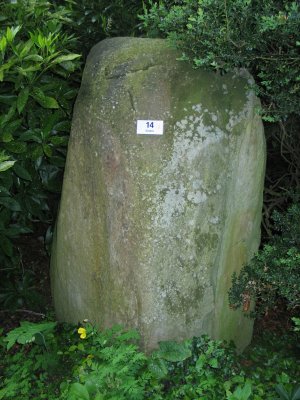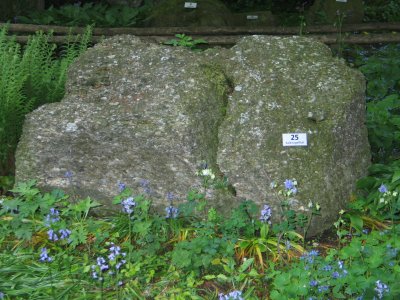Findlingsgarten in Romanshorn 🌍 EarthCache
Findlingsgarten in Romanshorn 🌍
-
Difficulty:
-

-
Terrain:
-

Size:  (other)
(other)
Please note Use of geocaching.com services is subject to the terms and conditions
in our disclaimer.
Findlingsgarten in Romanshorn

English version below ...
Ein Findling, auch Erratischer Block oder Erratiker [lateinisch erratus: "verirrt"] genannt, ist ein heute meist einzeln liegender großer Stein, der durch Gletscher während der Eiszeiten in seine heutige Lage transportiert wurde.
Der Name "Erratischer Block" entstammt der Tatsache, daß die Eiszeiten bis zum Ende des 19. Jahrhunderts nicht bekannt waren und sich Geologen diese "Verirrten" Steine, die rein garnichts mit dem sie umgebenden Gestein gemeinsam hatten, nicht erklären konnten.
 Die verschiedenen Eiszeiten haben den Bodenseeraum entscheidend geformt. Der Rheingletscher hat dabei sehr große Mengen an Gesteinsmaterial aus den verschiedenen Regionen der Alpen transportiert (bei diesen Blöcken hier bis zu 200km) und schließlich als "Visitenkarte" hinterlassen. Findlinge können daher ebenso wie Moränen, Drumlins, etc. Rückschlüsse auf die Herkunft und Ausdehnung der Gletscher geben. Die Größten können ein Volumen von mehreren Tausend Kubikmetern haben !
Die verschiedenen Eiszeiten haben den Bodenseeraum entscheidend geformt. Der Rheingletscher hat dabei sehr große Mengen an Gesteinsmaterial aus den verschiedenen Regionen der Alpen transportiert (bei diesen Blöcken hier bis zu 200km) und schließlich als "Visitenkarte" hinterlassen. Findlinge können daher ebenso wie Moränen, Drumlins, etc. Rückschlüsse auf die Herkunft und Ausdehnung der Gletscher geben. Die Größten können ein Volumen von mehreren Tausend Kubikmetern haben !
Teilweise wurden Findlinge auch als Steinbruch für Baumaterial genutzt. Sie sind daher teilweise oder ganz verschwunden.
Einige kleinere Exemplare dieser beeindruckenden Naturdenkmäler könnt Ihr hier im informativen Findlingsgarten entdecken. Die Findlinge stammen alle aus der Region (Bündnerland, St. Galler Rheintal und Appenzellerland). Auf der metallischen Übersichtstafel könnt Ihr die unterschiedichen Herkunftsorte, Gesteinsarten und deren Alter erkennen. Größere Blöcke findet Ihr einige Meter weiter Richtung Ufer.
Parken könnt Ihr in unmittelbarer Nähe (gebührenpflichtig).
Einige Quellen / Literatur:
- Regierungspräsidium Freiburg - Landesamt für Geologie
- Der Bodensee - Zustand, Fakten, Perspektiven (igkb)
- Wikipedia.de
- Infotafeln vor Ort
Aufgaben:
- Frage 1: Wie lautet die Antwort auf der blauen Tafel unten links ?
- Frage 2: Wie heißen die 4 auf der Metalltafel genannten Eiszeiten ?
- Frage 3: Welches Gestein kommt aus dem Pizolgebiet und wie alt ist dieses ?
- Foto: Macht ein Foto von Euch, dem GPS und den Findlingen im Hintergrund.
Sendet die Antworten mit "send message" an mich und Ihr könnt sofort mit Eurem Foto loggen.
Es ist nicht notwendig, auf eine Logerlaubnis zu warten !
Einen weiteren sehr interessanten Earth-Cache möchte ich empfehlen. Er ist nur wenige Minuten von hier entfernt:
GC20EQM - 'Inseli Romanshorn' von Valerossi
Erratic Boulder Garden in Romanshorn
A glacial erratic also called erratic block or boulder [they take their name from the Latin word errare], is a piece of rock that differs from the size and type of rock native to the area in which it rests. They are carried by glacial ice, often over distances of hundreds of kilometers.
Their name "erratic boulders" comes from the fact, that the idea of ice ages wasn't known until the end of the 19th century. Before this time, nobody was able to explain these stones that simply had nothing in common with the stones around them.
 The different ice-ages have formed the landscape around Lake of Constance decisively. The Rhine Glacier transported large quantities of clastic rock from the different regions of the Alps which were left after ablating several hundreds of kilometres away from home as a kind of "visiting card". Erratic blocks (just as moraines and drumlins) can be helpful in drawing conclusions about the origin and the expansion of the glaciers. The biggest can have a volume of several thousand cubic metres!
The different ice-ages have formed the landscape around Lake of Constance decisively. The Rhine Glacier transported large quantities of clastic rock from the different regions of the Alps which were left after ablating several hundreds of kilometres away from home as a kind of "visiting card". Erratic blocks (just as moraines and drumlins) can be helpful in drawing conclusions about the origin and the expansion of the glaciers. The biggest can have a volume of several thousand cubic metres!
Partially erratic blocks were also used as a stone quarry for building material. Hence, they are partially or completely disappeared.
Here you can discover some smaller exemplars of these impressive natural monuments in the informative erratic boulder garden. The boulders were found in the region (Bündnerland, St. Galler Rheintal and Appenzellerland). On the metallic-board you can see the different origins, types and ages of them. You can find some bigger boulders some meters from here at the border of Lake of Constance.
Some Sources:
- Regierungspräsidium Freiburg - Landesamt für Geologie
- Der Bodensee - Zustand, Fakten, Perspektiven (igkb)
- Wikipedia.de
- informationboards at location
ToDo:
- Question 1: What's the answer on the blue informationboard below on the left ?
- Question 2: What are the names of the 4 ice-ages called on the metallic-board ?
- Question 3: Which rock comes from the Pizolregion and how old is it ?
- Photo: Take a picture of you, the GPS and the boulders in the background.
Send the answers to the owner via 'send message' and you can log immediately with your photo.
It's not necessary to wait for an answer or for permission to log !
Additional Hints
(No hints available.)